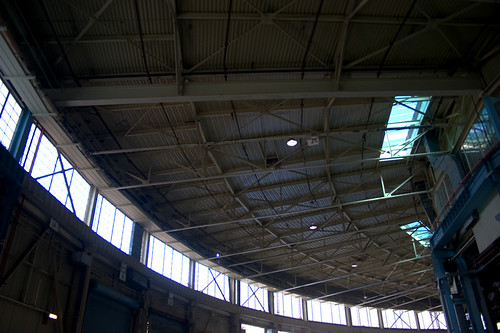Pripyat, Chernobyl, and the Future of Nuclear Power
 Show on map
Show on map
By Jonathan H

Inside Berkeley’s Bevatron, a particle accelerator. This is the type of complex that is getting Iran in trouble now, but obviously on a much larger scale. Though plutonium was never produced here, it was the site of the discovery of anti-matter.
In 1986, the world became aware of the meltdown at Chernobyl. The principle flaw resided in the RBMK design of the Soviet reactor and its dangerously high “positive void coefficient.” The design meant that, as the core’s surrounding temperature increased, the core itself produced more heat.
The results were devastating. Though the Soviet government never released any official “body counts” it’s estimated that as many as 9,000 have died indirectly as a result. The incidences of thyroid cancer have also increased, especially in Belarus, where much of the fallout ended up due to wind patterns. Many children were affected — National Geographic’s April 2006 issue contains vivid accounts of the disaster itself, along with some incredible photos by Gerd Ludwig.
Today, what remains is an abandoned city. What looks like post-apocalyptic grid of soviet-era apartment structures, school buildings, and hotels. The central square is eerily full of a ferris wheel and other fairground equipment. Doctors offices still have the dead plants sitting on their desks (20 years later), and schools are full of miniature gas masks, handed out to children in the haste of the disaster.
An incredible look into the abandoned city of Pripyat is in Robert Polidori’s book, Zones of Exclusion: Pripyat and Chernobyl. Once a city of 6,000, it has become a dead zone. Full of radioactive fallout, where, on the day of the disaster, children splashed water from fire hoses used to spray down streets full of radioactive cesium 137.
It’s a beautiful look at a soviet city. And yet, 20 years later, we have to ask ourselves if nuclear power is a very viable option. Technology like cold fusion may someday help save us from the deleterious effects of global warming. Maybe, some day, we will thank Uranium. But today, with Iran knocking on nuclear’s door, and North Korea building up its arsenal, we see why Einstein — who once supported nuclear research to fight off Nazi agression — changed his tune after the devestating bombs at Hiroshima and Nagasaki.

 Reddit!
Reddit! Del.icio.us
Del.icio.us Digg
Digg StumbleUpon
StumbleUpon Technorati
Technorati Blinklist
Blinklist Furl
Furl